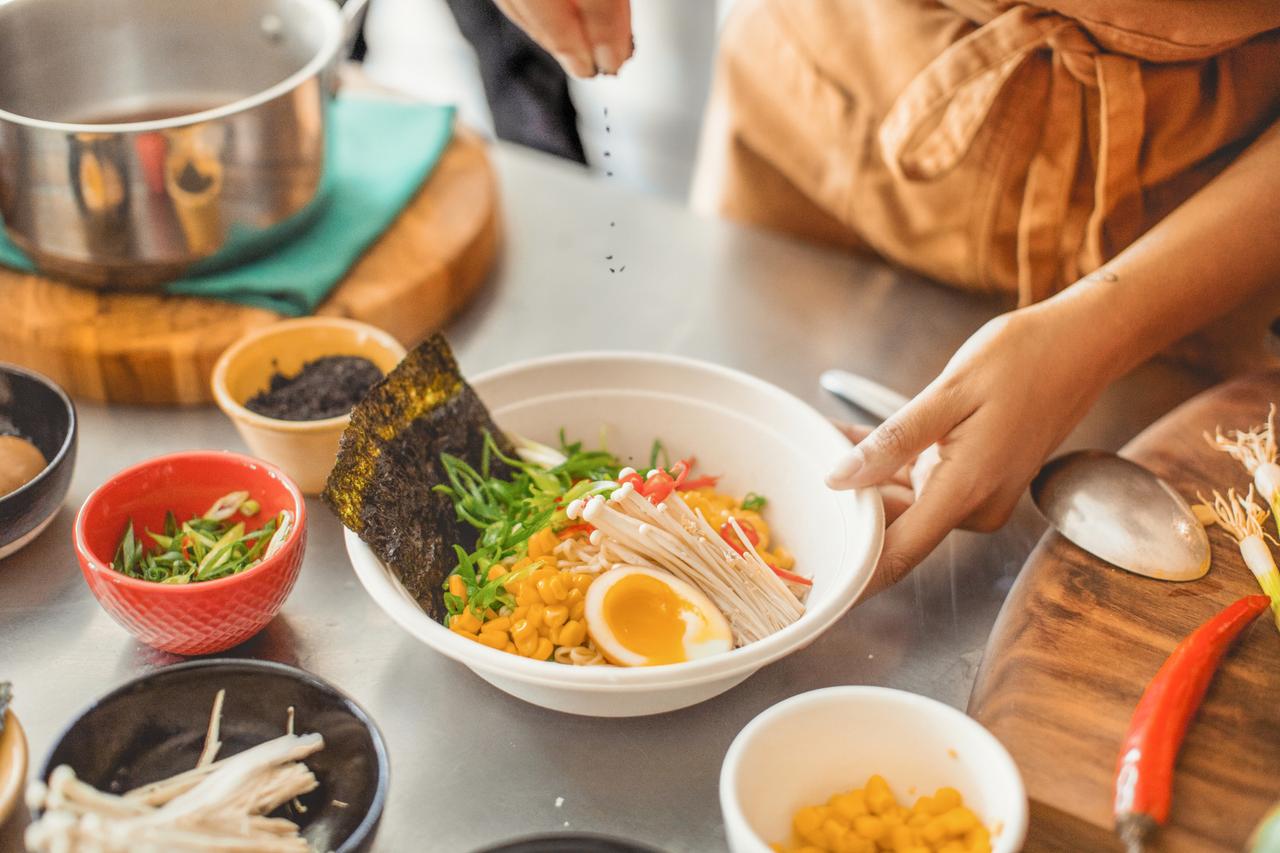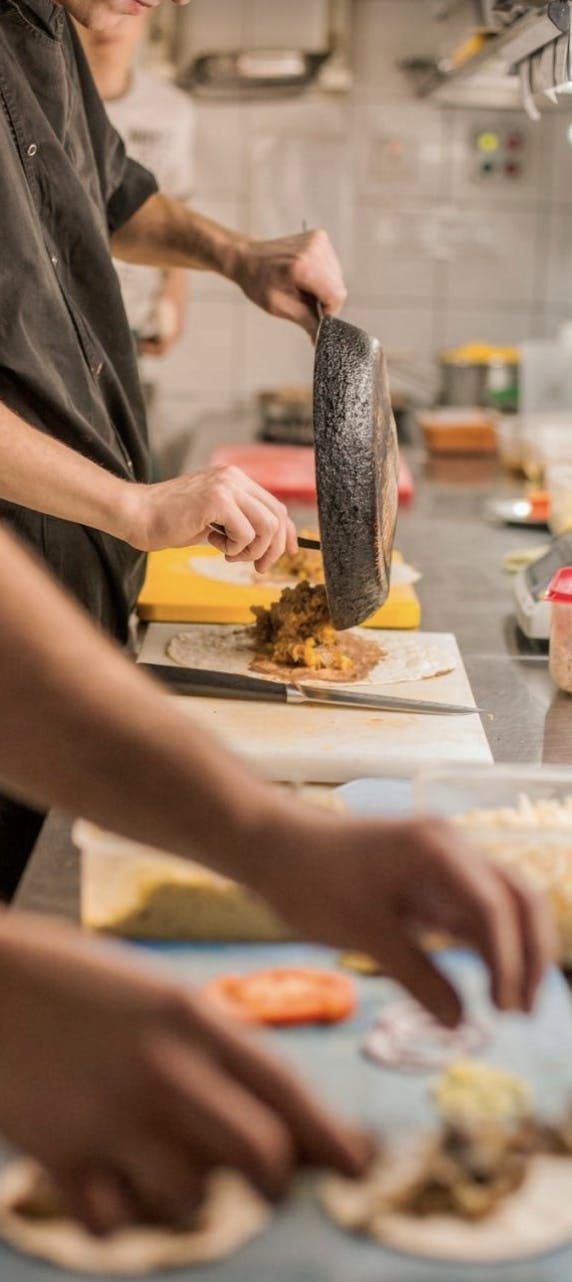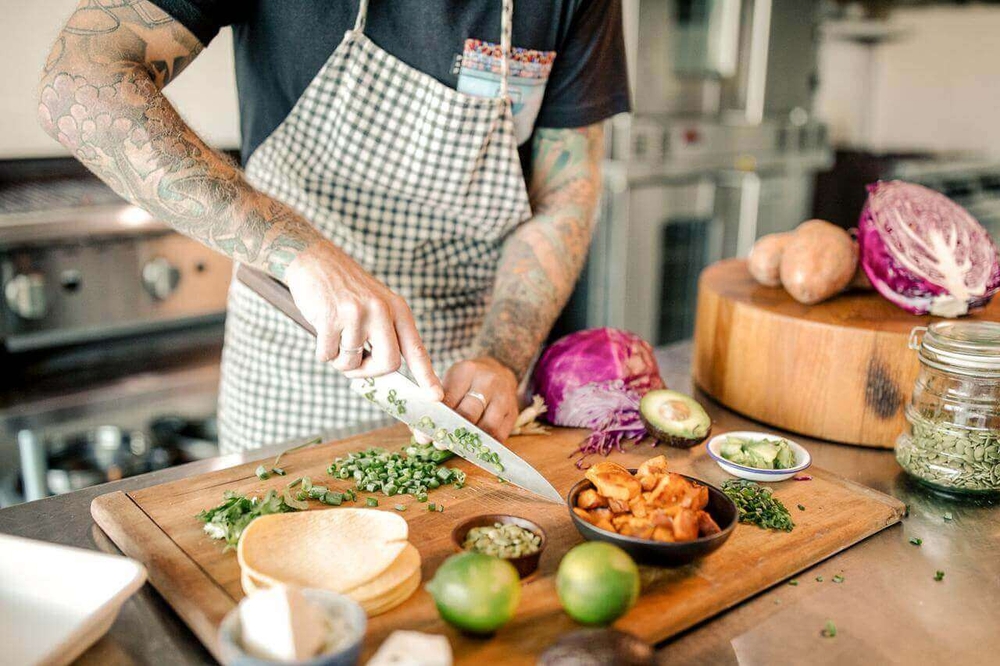5 Important Elements for Restaurant Branding
Table of Contents
CloudKitchens
How many tacos can be delivered from a 1000sqft restaurant?
The same amount as a 200sqft ghost kitchen.

Being the place that comes to mind when hungry people ask, “What do you want to eat tonight?” is the gold standard of restaurateurs. But how does a restaurant build a reputation that’s hotter than a blasting broiler?
With effective restaurant branding, of course.
A successful restaurant branding strategy is an important step in knowing how to start a restaurant business and it can turn a desolate diner into a hot spot for foodies near and far.
Aside from food and flavor, which you’ve already mastered, a few key factors come together to contribute to an excelling restaurant’s brand identity and brand personality. Let’s whip up the winning dish that plates your restaurant brand development above the rest.
1. Food is first and foremost
Luckily, you already have an excellent chef—whether it be you or a trusted captain at the helm of your kitchen. And make no mistake: your culinary craft is your primary brand identity and trademark.
Memorable restaurants have a specific idea in mind for their food during the menu engineering stage. They often offer a novel menu for guests that others in the area (or the world) can’t compete with.
Whether it’s through fusion or authenticity, serving delicious, unique dishes that outdo the competition makes an establishment one-of-a-kind.
It doesn’t matter if you’re the only place doing a Colombian-Czech combo, or you’re cooking regional Italian dishes to perfection. It’s the difference that matters. Offering something to guests that your peers don’t set you apart as an innovator in your space.
Food comes first when establishing a restaurant. Deciding on the menu sets the tone for your concept, and…
2. Concept is key
The concept goes beyond the dishes coming out of the kitchen. A business’s concept is conveyed in the story, space, and services it crafts for its customers.
That might sound fanciful or elusive, but we’re here to tell you that it is, in fact, realistic and achievable—and it starts with presenting your restaurant in a way that resonates with your customers.
Let’s consider these three elements of a restaurant concept:
- Story
- Space
- Services
2a. Story
It’s not just the tale of the food, although that is often intertwined with your overall brand’s story as a whole. The history behind the chef, the owner, the business, and the very reasons the restaurant exists are all part of the story your customers experience.
In the same way that celebrity chefs imbue their empires with their personalities and backgrounds, so too can your restaurant tell your story.
Whether a collection of grandma’s recipes or simply a showcase of your favorite flavors, your menu is the customer’s window to your culinary soul and should be reflected in your brand voice. If your story is that of Moroccan street delicacies, then use your brand identity to make sure that’s what they see when they peer into it.
And make sure that’s what they see when they look around them, as well. Speaking of which…
2b. Space
We go to restaurants not only to try delicious food but also to change our surroundings. We crave the low candlelight and slow, mellow music of a high-end steakhouse dining experience as much as we crave the charred cut itself.
Your story needs a setting, and the restaurant is the special space where your concept comes to life. It should match the brand voice & message you’re trying to send to your customers.
For example, elements in your space that can help actualize your brand personality are:
- Your furniture
- Your building materials
- Your decorations
- Your dinnerware
- Your menu design
Plastic stools may be cheap, but if you’re trying to capture the essence of a Mekong market for your Vietnamese concept, they could be the best choice—so long as they’re comfortable and sturdy. The needs of the customer and what you can do to serve them should be taken into consideration when fleshing out your concept.
2c. Services
Space is crucial to some restaurants, but to others, it isn’t always a top priority.
Small storefront cafes and takeout counters can set their concepts apart in other ways than a distinctive interior. Being the only Ethiopian joint that offers delivery in the area, for example, can define your business beyond brick-and-mortar’s face value.
Even paying attention to small details, like each and every order going out wrapped cleanly and neatly, can even set your business apart. In fact, customers place a significant amount of importance on packaging quality and presentation upon delivery, and a sloppy box may discourage their choice to order again.
Even if you’re not looking the customer in the eye, the experience your customer receives is. Make sure that it conveys the story you want to tell.
3. Logos make legends
Think of fast food chain restaurants that serve hamburgers. Now think of a letter in the alphabet. Now think of what color that letter is.
The big yellow M is perhaps the most recognizable of restaurant logos. Even reading about it might awaken hidden cravings you didn’t know you had.
The ease with which the simplest of symbols can convince you to buy a hamburger is proof enough of a restaurant logo’s centrality to a restaurant’s brand. While your menu might be slightly different than the iconic fast-food restaurant, your logo is the shortcut from a customer’s brain to your business.
When crafting your restaurant logo, consider:
- Readability
- Memorability
- Your restaurant
- The mood you want your restaurant to create
- Color psychology, or using colors to help convey mood
4. Determine your demographics
Knowing your target audience will help you determine several aspects of your business and the brand’s image. So to decipher your restaurant’s brand, you needn’t look further than your bar counter or dining room at your loyal patrons.
To understand your restaurant’s customers, consider these factors:
- Economics of the area: If you’re looking to serve up duck a l’orange and Beef Wellington cooked to the highest standard, perhaps a college campus isn’t an ideal location for customer engagement. If your heart is with cheap pub fare and cold beer, then perhaps it is. Know the spending capabilities of your customer base, and set your prices accordingly.
- The residents’ palates: Getting to know a neighborhood and the people who live there can help you decide what to serve up. For instance, perhaps a rural retirement community where most of the populace has restricted diets isn’t the place to debut your spicy curry concept. Find the balance between what people want, what they’re missing from other restaurants in the area, and what you can cook to perfection.
- Food familiarity: Are you mastering an area’s steadfast favorite or introducing something new and exciting? Classic is fantastic when done well, and being the best at something everyone does is certainly admirable. Alternatively, novelty brings the mystique and allure of unconquered flavors. Whatever choice you make will contribute to your restaurant’s brand.
These factors can coalesce naturally, resulting in (hopefully) repeat customers and regulars. When it does, make sure to foster a positive relationship with them to keep them coming back.
5. Engage with your customers online
If someone searches for your restaurant online and finds little to no presence, there’s a high chance that they’re not going to come through your doors.
If they really want to see a menu but you don’t have one available, there’s a high chance that they’re not going to place an order with you.
If your Facebook page hasn’t been updated since 2017…
Well, you get the idea.
When learning how to open a restaurant, you’ll learn that maintaining an online presence is an essential way to communicate your restaurant’s brand to customers, old and new. Online platforms give you a space where you can speak to your customers at any time.
Make sure you use your voice intentionally in spaces like:
- Your website: Having a website can be a make-or-break factor for many potential customers deciding if they want to give your restaurant a try. Keep a professional site stacked with high-quality photos of your dishes and space, and supply information on your most up-to-date menu and protocols.
- Google: Millions of people use Google every day to search for restaurants. In fact, online searches lead to more website hits than any other source. Keeping your restaurant updated on the world’s most popular engine can likewise help drive foot traffic. Make sure your hours, menu, and website links are up to date. And don’t forget to respond to those reviews!
- Social media: Facebook, Instagram, and Twitter are all vital lines of connection between a business and its clients. Posting from your restaurant’s profile is an effective way to develop an attitude and image for your brand when it comes to social media marketing for restaurants. Just make sure any food photos are high-quality to make your delectable dishes look as good as they taste!
Perfect the cuisine that defines your brand with CloudKitchens
Any conversations about how to build a restaurant brand begin with food at the forefront. Without the flavor to back up your brand, your restaurant’s reputation cannot flourish. Once you’ve mastered that and are ready to take your brand to hotter temperatures, step into CloudKitchens.
CloudKitchens provides top-of-the-line kitchens to equip you with the space you need to make your restaurant brand legendary.
We provide you with a state-of-the-art ghost kitchen fit with what you need to produce flawless (and well-packaged) takeout orders. We’ve also cooked up our own end-to-end delivery fulfillment technology to help you better serve your customers.
Your food and image tell the story of your brand. CloudKitchens provides that space to back up your cuisine’s promising reputation. Expanding your business with CloudKitchens to maximize its efficiency is the best way to increase revenue with less stress. You can do this by taking advantage of our ghost kitchens locations in Austin, Los Angeles, Chicago, Portland, San Francisco, and many more cities across the United States!
So what are you waiting for? Let’s cook up something incredible together.
Read More
- What is QSR? Understanding Quick Service Restaurants
- Google Ads for Restaurants: Drive More Traffic | CloudKitchens
- Restaurant Marketing: The Ultimate Guide | CloudKitchens
- Restaurant Expansion Strategy For Your Business
- 20 Different Types of Restaurant: A practical guide for entrepreneurs
Explore ghost kitchen locations across the US:
- Ghost kitchens in San Francisco
- Ghost kitchens in LA
- Ghost kitchens in NYC
- Ghost Kitchens in Toronto
- Ghost Kitchens in Atlanta
- Ghost Kitchens in Dallas
- Ghost Kitchens in Chicago
- Ghost Kitchens in Denver
- Ghost Kitchens in Miami
| DISCLAIMER: This information is provided for general informational purposes only and the content does not constitute an endorsement. CloudKitchens does not warrant the accuracy or completeness of any information, text, images/graphics, links, or other content contained within the blog content. We recommend that you consult with financial, legal, and business professionals for advice specific to your situation. |
Sources:
EHL Hospitality and Business School. The 7 components of designing a hotel concept. https://hospitalityinsights.ehl.edu/
British Food Journal. A model of online food delivery service quality, customer satisfaction, and customer loyalty: A combination of PLS-SEM and NCA approaches. https://www.researchgate.net/
National Library of Medicine. Brand name logo recognition of fast food and healthy food among children. https://pubmed.ncbi.nlm.nih.gov/
Social Media Today. New Report Looks at the Top Website Traffic Drivers by Vertical. https://www.socialmediatoday.com/
More insights & stories
There’s more where that came from.
Get in the know and check out our additional insights



